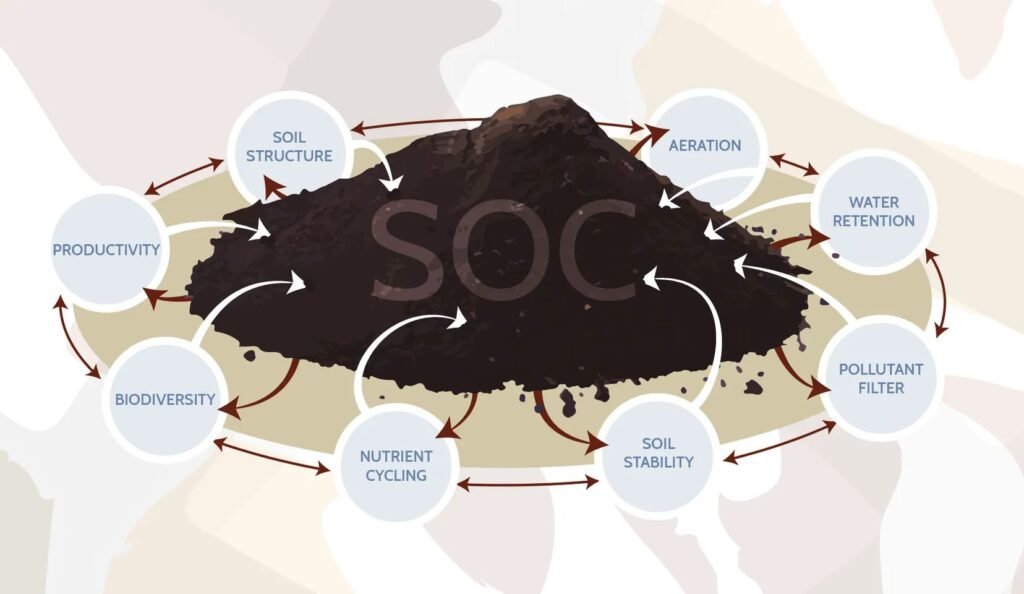Food and climate, environment, society, and economy
As you learned in the first topic, food systems are complex. They include the production of food from agriculture, forestry, and fisheries, the aggregation of food, and its processing, distribution, consumption, and disposal. With all of these components, food systems depend on natural resources and the socio-economic environment just as much as they can impact them. It is therefore worth taking a closer look at the different interlinkages.
Food, climate & environment
Let’s take a closer look at the linkages between food, climate, and the environment with the video from Prof. Dr. Andy Nelson.
How do we use our resources?
Water, land, and climate are essential resources for agriculture.
How do we use our land?
Agriculture takes up a big part of our land. Only around 71% of the global land resources are habitable and of that land, half is used for agriculture. Of all agricultural land, 77% is used for livestock and dairy farming, and only 23% is used to grow crops. However, those crops provide 82% of our calories and 63% of our protein.
Explore the map of global land use for food production per country.
How do we use freshwater?
As displayed in these plots, the agricultural sector is very demanding of freshwater resources (70 % in total), with different shares across regions.
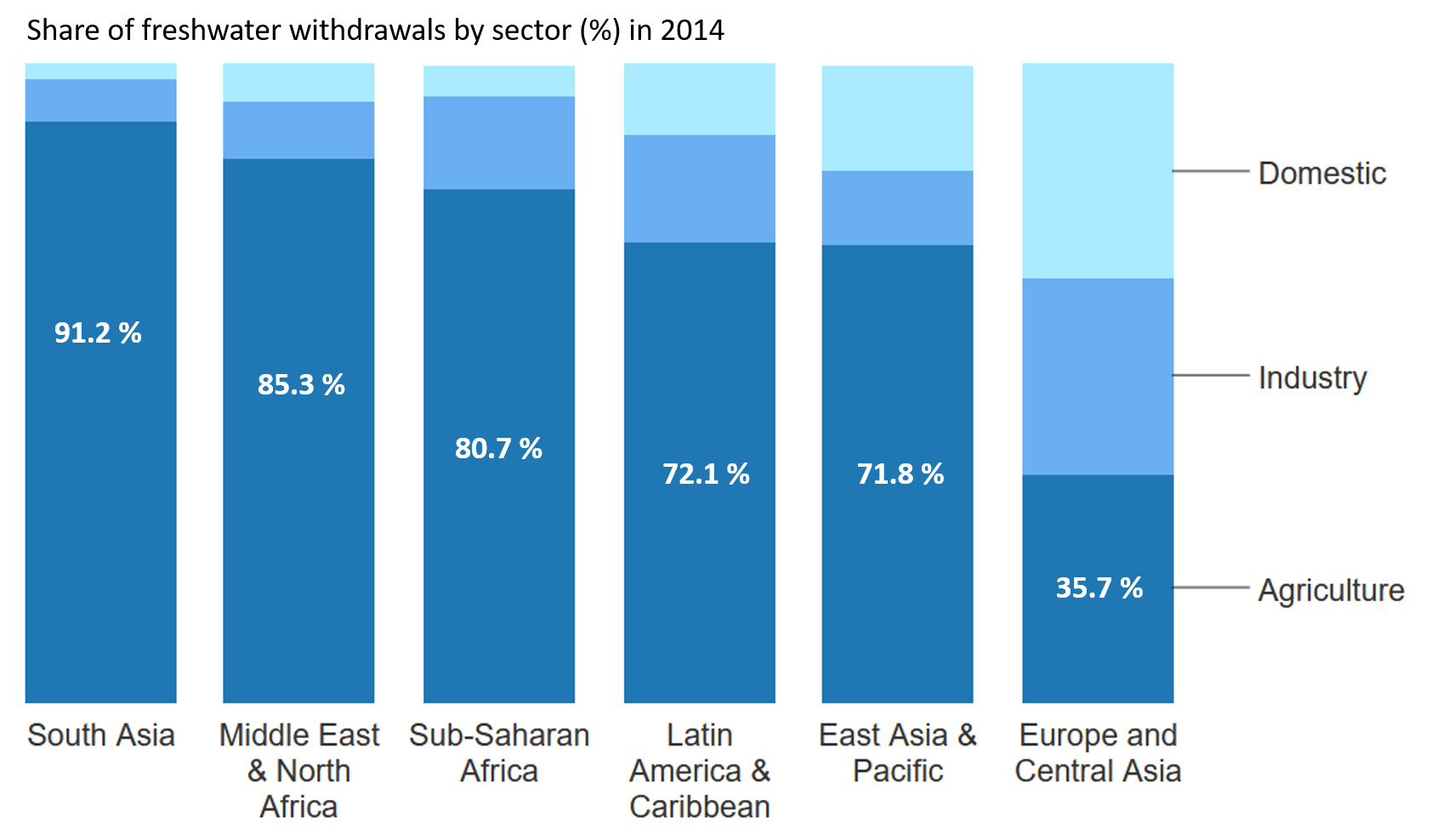
Agriculture, including livestock keeping, supports the livelihoods of billions of people, making a substantial contribution to economies. Global agriculture continues to evolve and develop to meet our demands. But: It threatens natural resources and contributes to climate change.
Land, water, atmosphere, and food security
Food production is embedded in the Earth’s natural environment. All ecosystems managed or unmanaged, interact with land, water, and the atmosphere, depending on the way they are structured and how they function. Their albedo and emissivity affect the amount of solar and long-wave radiation which is absorbed by land and reflected or emitted to the atmosphere. Surface roughness influences turbulent exchanges of momentum, energy, water, and biogeochemical tracers. Which amounts of greenhouse gas emissions (GHGs) and precursors of short-lived climate forces (SLCFs) like mineral dust and biogenic volatile organic compounds (BVOCs) are released to or removed from the atmosphere by land ecosystems modulates the atmospheric composition. The regional climate is affected by atmospheric aerosols that are formed from these precursors by altering the amounts of precipitation and radiation reaching the land surface through their role in clouds physics (IPCC, 2019).
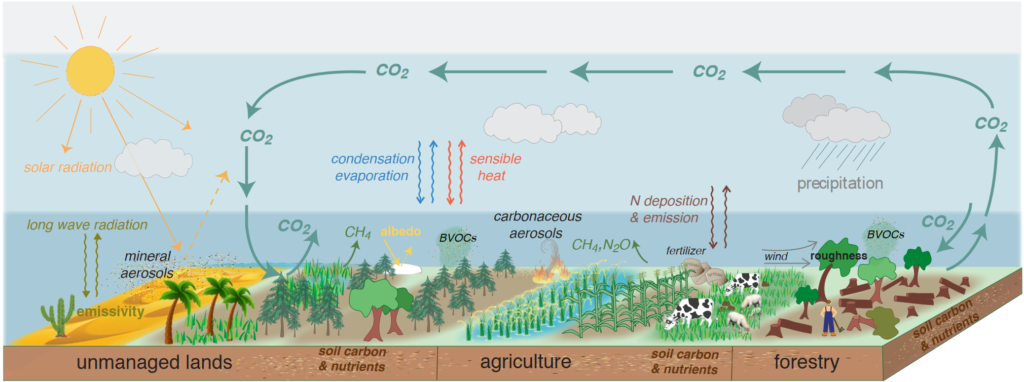
Soil and food security
Soils sustain agriculture and stock carbon: Soils are the world’s largest terrestrial carbon sink. Therefore, they have the capacity to buffer climatic changes. Vice versa, soils emit climate change-enhancing GHGs when they are degraded.
Soil Organic Matter (SOM) is critical for the stabilization of soil structure, the exchange of plant nutrients, and water infiltration and storage. Soil Organic Carbon (SOC) is its main component. It is what is left in the soil after any material produced by living organisms has been partially decomposed. Decreasing SOC in soils indicates soil degradation, as entailed by unsustainable management practices, which decreases soil health and negatively affects food production. Worldwide, a third of the soils are degraded according to the Status of the World’s Soil Resources (SWRS) report, which puts food security and climate change mitigation goals at risk.
On the flip side, reversing soil degradation and building up SOM yields great potential to improve water and nutrient availability and thus food productivity, as well as to slow down climate change by decreasing the concentration of CO2 in the atmosphere. Moreover, food production systems grow more tolerant towards extreme climate phenomena like drought if the SOC in soils is improved. A small increase in SOC in the topsoil (0-30 cm) could improve drought tolerance through increased fertility and efficient water use of the food production systems over 70% of the harvested area worldwide, particularly in drylands.
Closing the gap between the current and upper limit of tolerance levels of SOC in soils globally has the potential of increasing farmers’ economic output by about 16% in drought years and of co-benefitting the climate by reducing global decadal mean temperature warming by 0.011°C. Rendering land management more sustainably is a crucial step toward leveraging this potential.
Browse the UN FAO’s Global Soil Organic Carbon (GSOC) map, which is a joint mapping effort of currently 88 contributors. Notice the spatial differences. Some ecosystems’ soils like the Great Cuvette’s swamps in the Democratic Republic of the Congo are particularly rich in SOC.
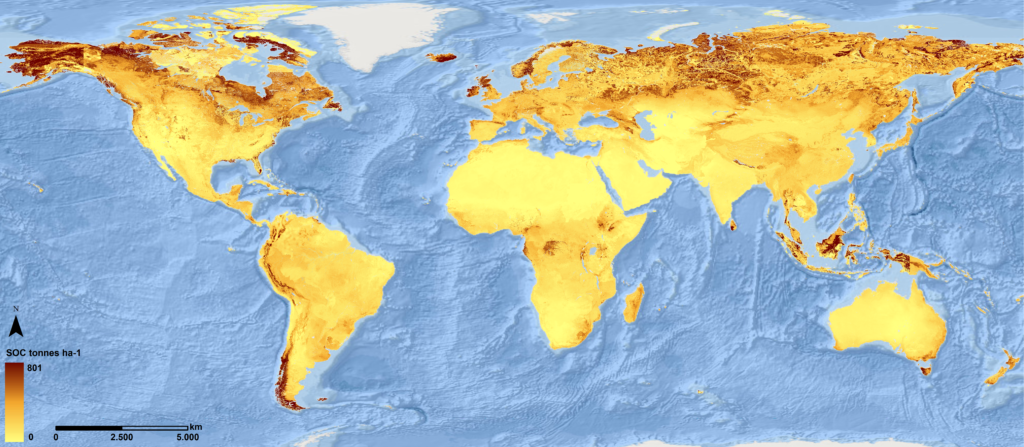
Source: http://54.229.242.119/GSOCmap/, FAO 2022.
Big impacts of climate change on food
The impacts of climate change on agriculture are manifold and vary across regions, crops, and food production practices, and have different dimensions. These include effects on crop productivity, food quality, risk of harvest failure, risk and patterns of pests, crop and livestock disease, as well as of post-harvest losses.
Source: Barange et al., 2018; FAO, 2017b; Mbow et al., 2019
Big impacts of food on climate change
21-37% of total GHG emissions are attributable to the food system, which impacts the Earth’s climate in multiple ways, directly and indirectly. GHG emissions accrue when carbon sinks like forests or peatlands are cleared or drained to accommodate agricultural production, and their carbon sequestering function is thus lost.
Land management practices like burning, and certain food production systems in particular rice cultivation and livestock directly contribute to the amount of GHG gases in the atmosphere. But also all other activities around food production which require energy, like processing, packaging, storage, or the transport to markets, increase the footprint of our food on climate.
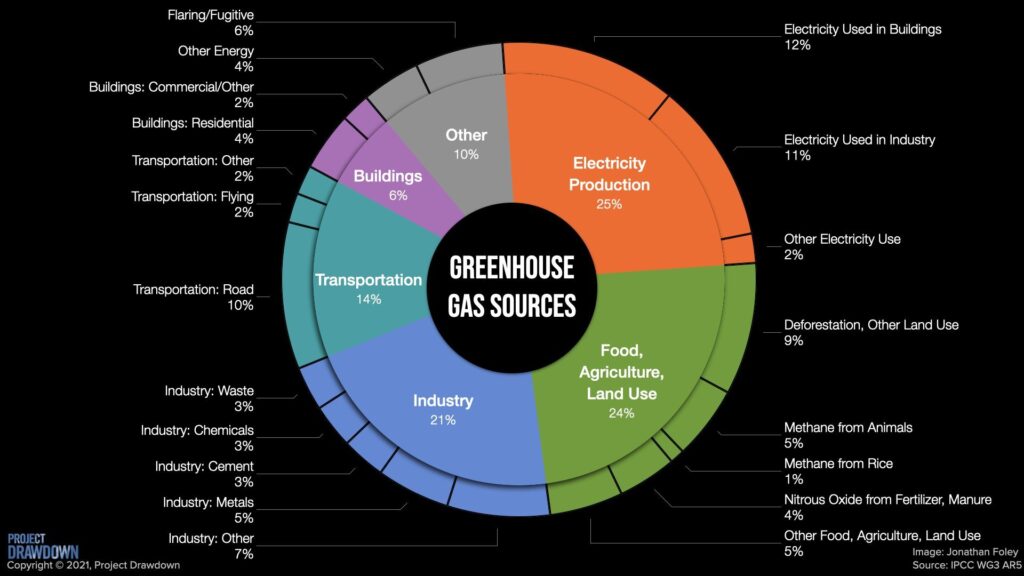
Agricultural emissions have increased in the last 20 years due to rapid growth in agricultural production. Explore the below chart for sector-wise greenhouse gas emissions around the world.
The IPCC projects that, with an increasing global population, income growth, and dietary transitions, GHG emissions from agriculture and livestock are likely to increase by another 30-40% by 2050, if no countermeasures are taken. Critical points are (Mbow et al., 2019):
Food, society & economy
Let’s discover the linkages between food, society, and the economy with the video from Prof. Dr. Andy Nelson.
The natural environment plays a crucial role in food production. But food, society, and the economy are also interconnected.
Agriculture is a big economic factor globally. The agricultural sector employs around one billion people and 2.6 billion people depend on agriculture for their livelihood. The total market value of crop production is 10 trillion €/year, so agriculture is a large part of our economy and society.
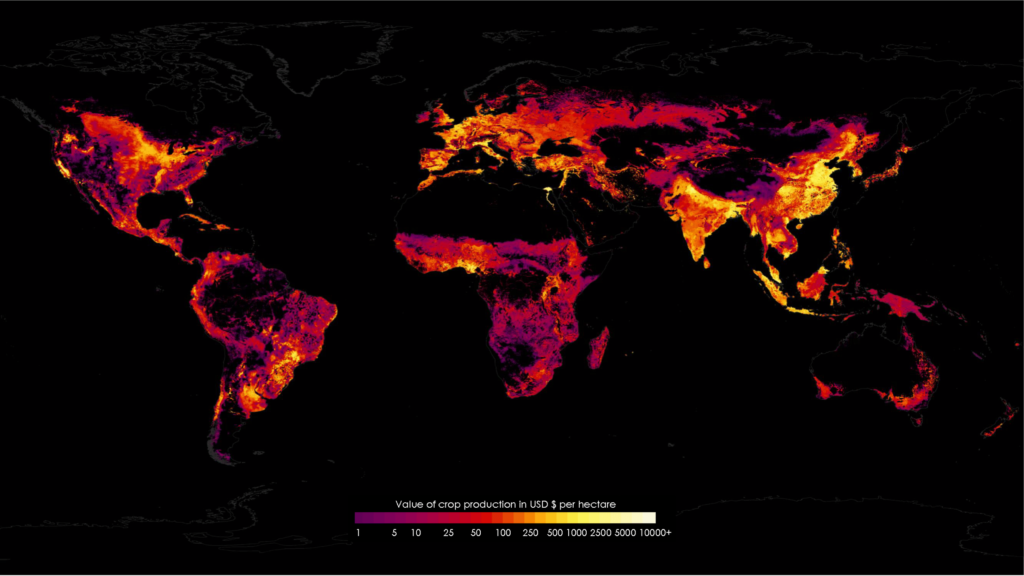

We only use one-third of the land for a unit of food, compared to the land needed in 1961. Technology has helped us grow more food on the same amount of land, e.g., thanks to new, higher-yielding varieties, improved land, and water management, and the increased use of artificial fertilizers.
However, these improvements have not resulted in equal benefits around the world.
In this graph, all cereal production in 1961 was scaled to 1 to see where the gains are over time. Yields have increased substantially in some regions in the world, but comparably only very little in others. The gains from new technology have not been the same everywhere. Most parts of Asia benefitted from the Green Revolution, consisting mainly of new varieties, improved irrigation, and fertilizer use, but most of Africa did not.
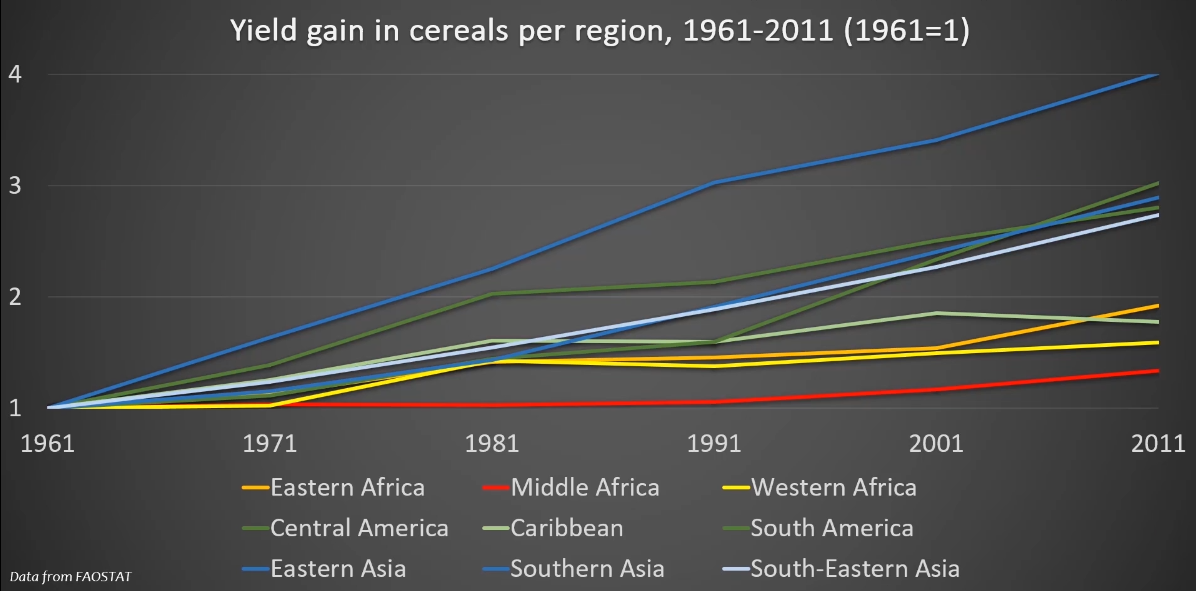
The maps below substantiate the claim of geographically unequal trends. They show how many calories were available per person in 1961 and in 2014. Those countries that are dark green were able to supply sufficient food to their population to meet their caloric needs. But in some parts of the world, particularly in southern and central America, Africa, and Asia, countries were not able to do so in 1961. By 2013, many of those countries have increased their ability to provide sufficient food. However, it is still not ideal in all parts of the world.
Society and food security
Besides the amount of available calories per person in a world of a still growing population, the type and quality of food that is consumed can be considered. This plays a role when it comes to health outcomes on the one hand. On the other hand, the demand for certain food groups has an effect on food provision and thus also on the related use of natural resources.
The dietary transition from cereal– to protein-, and particularly meat-rich diets can be linked to income growth and urbanization trends. While urbanization was a phenomenon of high-income countries until the 1970s, low-income countries are experiencing high urbanization rates since. In fact, livestock production has been one of the fastest-growing agricultural subsectors in low-income countries. Globally, per capita consumption of meat has almost tripled since the early 1970s, and per capita consumption of fish has more than doubled.
Other social factors that play a role in food security are gender and equity, age, ethnicity, wealth, and class. Different groups tend to have different food requirements, dietary choices, and roles in the food system, or are more vulnerable or more resilient to food insecurity. Thus, for example, expected cereal price increases due to the effects of climate change will have varying impacts across regions and groups.
There is evidence that our food supply systems can adapt to the challenges of meeting future food demands. However, despite the substantial improvements in food production, over 800 million people still suffer from hunger and 2 billion are malnourished. And despite the overall trend of declining hunger, the uptick since the middle of last decade is concerning. The harsh rise in the number of undernourished people, which can be attributed to the COVID-19 pandemic, uncovers the vulnerability of food systems to societal shocks.
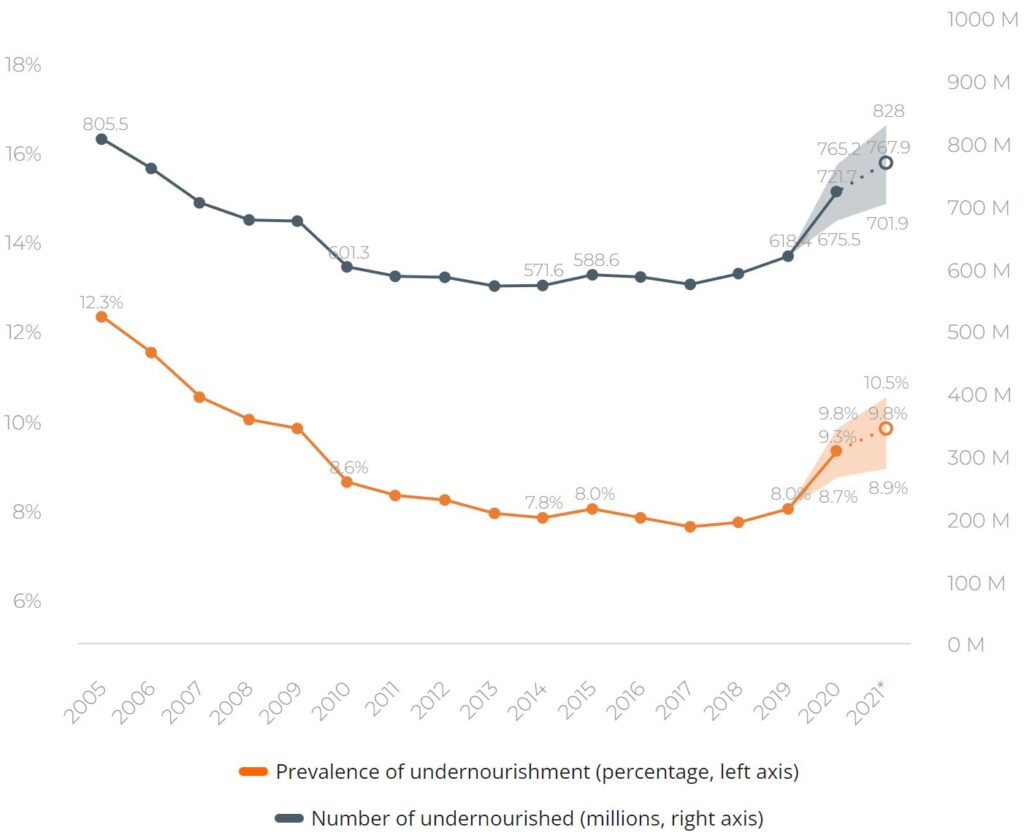
Source: FAO, The State of Food Security and Nutrition in the World 2022. Data are available on FAOSTAT
To sum up, many factors play a role when looking at food systems and food security. Food system activities, climate and the environment, and society and the economy, all influence food system outcomes, as well as one another. In turn, food system outcomes have an impact on climate and the environment, and society and the economy. When looking at food security, all aspects and layers of these complex interlinkages need to be considered in their spatial and temporal dimensions.

Credit
This topic is created with the help of learning materials kindly provided by Prof. Dr. Andrew Nelson, International Institute for Geo-Information Science and Earth Observation (ITC), University of Twente.
Sources and further readings
Sources
Barange, M., Bahri, T., Beveridge, M.C.M., Cochrane, K.L., Funge-Smith, S., Poulain, F., 2018. Impacts of climate change on fisheries and aquaculture: synthesis of current knowledge, adaptation and mitigation options. FAO, Rome, Italy.
FAO, 2017. Global Soil Organic Carbon Map Version 1.2.0.
FAO, n.d.-a. Agricultural land use, 2018. URL https://ourworldindata.org/grapher/agricultural-land
FAO, n.d. -b. Annual freshwater withdrawals, agriculture (% of total freshwater withdrawal). World Bank Data. https://data.worldbank.org/indicator/er.h2o.fwag.zs.
FAO, ITPS, 2015. Status of the World’s Soil Resources (SWSR) – Main Report. Food and Agriculture Organization of the United Nations and Intergovernmental Technical Panel on Soils, Rome, Italy.
FAO, 2017. The future of food and agriculture: trends and challenges. Rome, Italy.
FAO, 2021. FAO Statistical Yearbook 2021 – World Food and Agriculture. Rome, Italy. https://doi.org/10.4060/cb4477en
FAO, 2021. The State of Food Security and Nutrition in the World 2021. FAO, IFAD, UNICEF, WFP and WHO. https://doi.org/10.4060/cb4474en.
Godfray, H.C.J., Beddington, J.R., Crute, I.R., Haddad, L., Lawrence, D., Muir, J.F., Pretty, J., Robinson, S., Thomas, S.M., Toulmin, C., 2010. Food Security: The Challenge of Feeding 9 Billion People. Science 327, 812–818. https://doi.org/10.1126/science.1185383.
Iizumi, T., Wagai, R., 2019. Leveraging drought risk reduction for sustainable food, soil, and climate via soil organic carbon sequestration. Sci. Rep. 9, 19744. https://doi.org/10.1038/s41598-019-55835-y
IPCC, 2019. Climate Change and Land: an IPCC special report on climate change, desertification, land degradation, sustainable land management, food security, and greenhouse gas fluxes in terrestrial ecosystems.
Khokhar, T., 2017. Chart: Globally, 70% of Freshwater is Used for Agriculture. World Bank Blogs. https://blogs.worldbank.org/opendata/chart-globally-70-freshwater-used-agriculture.
Kingsman, J., 2019. The cost of food subsidies. Commod. Conversat. http://commodityconversations.com/wordpress2/2019/12/30/the-cost-of-food-subsidies/.
Kopainsky, B., Tribaldos, T., Ledermann, S.T., 2018. A Food Systems Perspective for Food and Nutrition Security beyond the Post-2015 Development Agenda: A Food Systems Perspective for the Post-2015 Development Agenda. Syst. Res. Behav. Sci. 35, 178–190. https://doi.org/10.1002/sres.2458.
Mbow, C., Rosenzweig, C., Barioni, L.G., Benton, T., Herrero, M., Krishnapillai, M., Liwenga, E., Pradhan, P., Rivera-Ferre, M.G., Sapkota, T., Tubiello, F.N., Xu, Y., 2019. Food Security, in: Climate Change and Land: An IPCC Special Report on Climate Change, Desertification, Land Degradation, Sustainable Land Management, Food Security, and Greenhouse Gas Fluxes in Terrestrial Ecosystems. pp. 437–550.
Ritchie, H., Roser, M., 2020. CO2 and Greenhouse Gas emissions. Our World Data. https://ourworldindata.org/emissions-by-sector.
Ritchie, H., Roser, M., 2019a. Land use. Our World Data. URL https://ourworldindata.org/land-use#how-the-world-s-land-is-used-total-area-sizes-by-type-of-use-cover.
Ritchie, H., Roser, M., 2019b. Meat and Dairy Production. Our World Data. https://ourworldindata.org/meat-production.
United Nations Statistics Division, 2021. SDG 2 End Hunger Achieve Food Secur. Improv. Nutr. Promote Sustain. Agric. https://unstats.un.org/sdgs/report/2021/goal-02/.
Further reading
Crippa, M., Solazzo, E., Guizzardi, D., Monforti-Ferrario, F., Tubiello, F. N., & Leip, A. (2021). Food systems are responsible for a third of global anthropogenic GHG emissions. Nature Food, 2(3), 198–209. https://doi.org/10.1038/s43016-021-00225-9
Wezel, A., Herren, B. G., Kerr, R. B., Barrios, E., Gonçalves, A. L. R., & Sinclair, F. (2020). Agroecological principles and elements and their implications for transitioning to sustainable food systems. A review. Agronomy for Sustainable Development, 40(6), 1–13. https://doi.org/10.1007/s13593-020-00646-z
You gained insight into how natural resources, climate, environment, society, and economy are linked with food systems.
Next, let’s take a look at the challenges we are facing regarding food security.
Complete the quiz below to advance to the next topic!
Discussion
-
Food and climate, environment, society, and economy
Sorry, there were no replies found.
Log in to reply.



